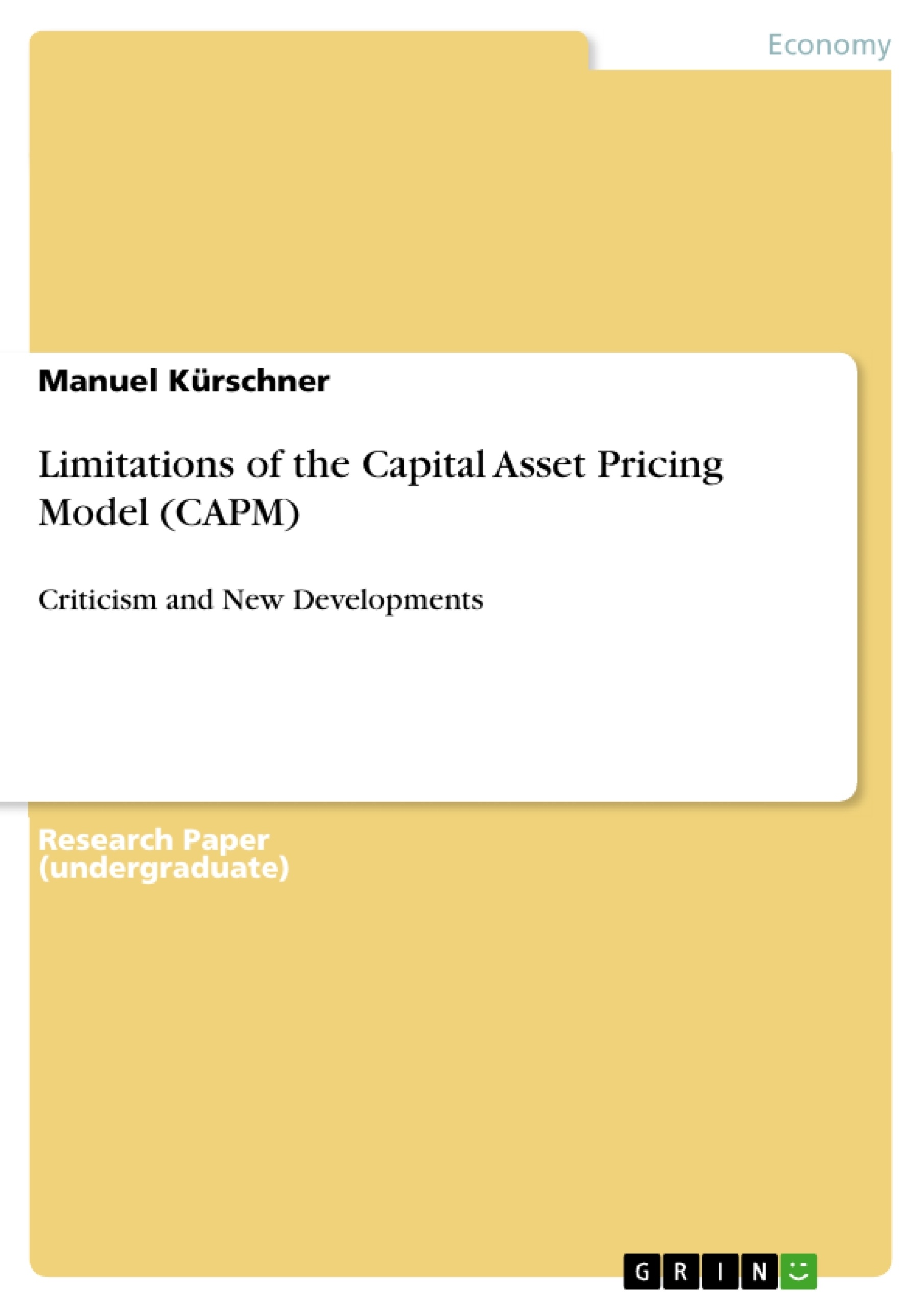The objective of this paper is to give an overview of the most important movements of the complex area of asset pricing. This will be tried by logically structuring and building up the topic from its origins, the Capital Asset Pricing Model, and then over its main points of critique, in order to arrive at the different options developed by financial science that try to resolve those problematic aspects.
Due to the complexity of this subject and the limited scope of this paper, obviously it will not be possible to discuss each model or movement in depth. Coherently, the aim is to point out the main thoughts of each aspect discussed. For further information, especially concerning the deeper mathematical backgrounds and derivations of the models, the author would like to refer the reader to the books mentioned in this paper. Many of those works, finance journal publications and the literature on asset pricing in general, set their focus on different parts of this paper, which again underlines the complexity in terms of scientific scope and intellectual and mathematical intricacy of this topic.
Table of Contents
- Introduction
- Introduction to asset pricing
- Objective of this paper
- The Capital Asset Pricing Model
- Derivation of the CAPM
- Firm-Specific Risk vs. Market Risk
- The beta coefficient
- The CAPM Equation
- The Security Market Line (SML)
- Assumptions of the CAPM
- Derivation of the CAPM
- Problems of the CAPM
- Unrealistic assumptions
- Empirical Testing of CAPM
- General Testing Problems
- The Problem of ex ante Data
- Roll's critique
- Results of empirical Tests
- Controversy about Beta
- Empirical support for other risk factors
- Conclusion
- General Testing Problems
- New Developments
- Neoclassical Models - Traditional Asset Pricing
- ‘Smaller' adjustments of the CAPM
- Zero-Beta CAPM
- Introducing taxes and transaction costs
- International Capital Asset Pricing Model
- Option pricing in CAPM context
- Multi-factor Models
- The Arbitrage Pricing Theory (APT)
- Fama-French Three-Factor Model
- Multi-period models
- The intertemporal CAPM (ICAPM)
- The Consumption-Based CAPM (CCAPM)
- Production-based Asset Pricing Model
- General Puzzles of Traditional Asset Pricing Models
- Equity premium puzzle
- Risk-Free Rate Puzzle
- ‘Smaller' adjustments of the CAPM
- Behavioral Finance
- Introduction
- Evidence contradicting the efficient market
- IPO Palm
- Royal-Dutch-Shell shares
- Pillars of Behavioral Finance
- Psychology
- Limits to arbitrage
- Summary
- Prospect-Theory Model
- Key Elements
- Assessment
- Habit Formation Models
- Models with heterogeneous Agents
- Conclusion
- Chaos, synergetic models and neural networks
- Neoclassical Models - Traditional Asset Pricing
- Conclusion
Objectives and Key Themes
This special research paper delves into the limitations of the Capital Asset Pricing Model (CAPM), critically examining its assumptions and empirical validity. It explores various criticisms and proposes alternative approaches to asset pricing, encompassing both neoclassical and behavioral finance perspectives.
- The theoretical underpinnings and limitations of the CAPM
- Empirical evidence and controversies surrounding the model's effectiveness
- Alternative asset pricing models, including multi-factor and behavioral finance approaches
- The implications of behavioral biases and market inefficiencies for asset pricing
- The role of risk, return, and market dynamics in determining asset values
Chapter Summaries
- Introduction: Introduces the concept of asset pricing and sets the stage for the critical examination of the CAPM. The paper's objectives and scope are outlined.
- The Capital Asset Pricing Model: This chapter delves into the fundamental principles of the CAPM, outlining its derivation, the Security Market Line, and its key assumptions. It explores the relationship between risk, return, and market dynamics.
- Problems of the CAPM: This chapter analyzes the criticisms and limitations of the CAPM, focusing on the model's unrealistic assumptions and empirical evidence. It examines the challenges in testing the model and explores the controversies surrounding beta.
- New Developments: This chapter explores alternative approaches to asset pricing beyond the traditional CAPM, encompassing neoclassical models, behavioral finance, and other emerging perspectives.
Keywords
The paper focuses on the Capital Asset Pricing Model (CAPM), its limitations, and alternative asset pricing models. Key themes include market risk, beta, asset pricing, efficient market hypothesis, behavioral finance, multi-factor models, arbitrage pricing theory, risk aversion, and investor psychology.
- Citation du texte
- Manuel Kürschner (Auteur), 2008, Limitations of the Capital Asset Pricing Model (CAPM), Munich, GRIN Verlag, https://www.grin.com/document/92947



